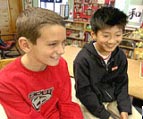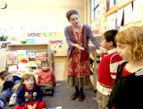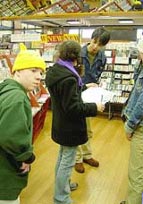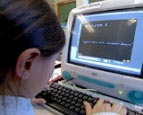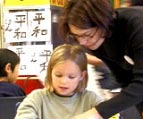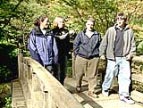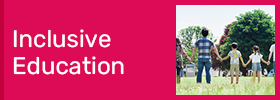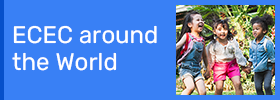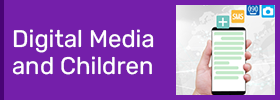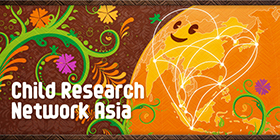A Model Program Mason attends Richmond Elementary School in Portland, Oregon, a school that, along with Mt. Tabor Middle School and Grant High School, houses a 15-year-old Japanese language partial immersion magnet program that has been called a model for language learning by researchers from the Center for Applied Linguistics. Students follow the Oregon state curriculum, using Japanese for half the day and English for the other half. On graduation from the program, which starts in kindergarten and goes through Grade 12, they have completed their state requirements and acquired a language as well. Mason's mother, Aimee Virnig, says, "Japanese is an extra for us. It just happens. I can't imagine how wonderful it would be to graduate from school with such a real skill." Foreign language programs are rare in the United States. A recent Senate resolution cites 2000 census data as showing that 9 percent of Americans speak their native language and another language fluently, compared to 53 percent of Europeans. But since the 9/11 tragedy exposed American students' lack of world knowledge (during the height of U.S. involvement in Afghanistan, only 17 percent of students could find that country on a map), international education has become a buzzword. U.S. Secretary of Education Rod Paige recently declared 2004-2005 the "The Year of Languages in the United States," encouraging schools to teach foreign languages and cultures. "We need to put the 'world' back in 'world-class education,'" said Paige. A Real-World Classroom Approach
"Partial" immersion refers to the fact that Japanese only takes up half of the day. During that time, students are immersed in language. Japanese Resource Teacher Deanne Balzer says, "With immersion, you have to pay attention to the language in order to be able to take part. By copying the teacher, students learn to ask for survival things. We call it functional phrases: 'May I go to the bathroom?' 'May I have a glass of water?' Everyday language." Studies show that studying language at an early age can encourage brain development. In "What Parents Want to Know About Foreign Language Immersion Programs," Tara W. Fortune and Diane J. Tedick write, "It has been suggested that the very processes [immersion] learners need to use to make sense of the teacher's meaning make them pay closer attention and think harder. These processes, in turn, appear to have a positive effect on cognitive development." To show students language modeled by native speakers, each classroom obtains a Japanese aide through the nonprofit Amity Institute's teaching exchanges. Interaction with the aides not only provides modeling of language and manners, it provides modeling of tolerance, says kindergarten teacher Amy Grover. "Children are quick to mirror respect for different ways of doing things." Taking Language Beyond the Classroom
Portland students also visit Japan in eighth grade for a two-week research residency, in which each student completes an interdisciplinary academic project. In Japan, students are based in the small agricultural town of Santo, in Hyogo prefecture, from which they explore the country, researching subjects such as geisha culture and swordmaking. High school freshman Kaia Range recalls making connections with native speakers on the train. "I asked [an elderly woman] a question about my homework and we got to talking," she says. "I didn't understand everything, but I got major things -- she pointed out where she was born and told me about how much snow there was when she was little." In the summer after eighth grade, a delegation of Santo townspeople visits the students in Portland. Technology With the Power to Transport
"Konnichiwa, hajimete no yukiga chyoto futta no de minna wa totemo ureshikatta desu. So shite, takusan no hito ga chisana yuki daruma wo tsukute yuki ga sen moshiteimashita. Keredomo, ima zenbu nakunate shimaimashita," begins one e-mail from students Anna Colon and Megan Warner. Translated, this reads: "Hello, we just had our first short snow fall and everyone was delighted. So many of us made small snowmen and had a snowball fight. But now the snow is all gone." Students also learn to conduct Japanese Internet research. Fourth-grade teacher Atsuko Ando teaches her class to search with Japanese characters rather than phonetic English spellings. She is particularly fond of a site called Kids Goo, which enriches vocabulary by displaying each result in katakana, hiragana, and kanji. Access to a Japanese World Wide Web gives students an insider's view of the culture. Parents Passionate About Language Benefits
Others believe that studying a language helps children who are not textbook learners. Aimee Virnig says, "My eldest is a vocal learner, and this is something where you're rewarded for speaking. This is something he can excel at." Denise Van Leuven's older daughter "needs input from more sensory areas. Reading and writing are difficult for her. But kanji and katakana and hiragana are not difficult for her to write; English is. Having those two ways to come at one subject has been a big help to her." The dedication of JMP parents, who call themselves Oya No Kai ("parent group"), makes much of this program possible. The nonprofit group's active fundraising ensures that every child can go on the fifth- and eighth-grade trips. Oya No Kai has also paid for school supplies and curriculum consultants, and has lobbied the school board to promote the program. The group sponsors Japanese interns, finding them host families and helping with visas, and it coordinates home stays when the Japanese students visit Portland. The Road Ahead
Student Karin Loch did her part during the 2003 Omiyage Banashi, or "Souvenir Stories" meeting, in which students give presentations to the community about the eighth-grade trip and the magnet program. "It was our proficiency in the Japanese language and culture that made the difference," Loch said. "Using our adopted language we were able to connect with, learn from, and laugh with our host families. Using our Japanese, we became not just observers, but players on the stage of life." The following Web sites appeared in this article: Ashley Ball (2004) A Common Language Creates an Uncommon Bond. Child Research Net. Retrieved Apr. 9, 2004, from the World Wide Web (http://www.glef.org/index.php) CRN would like to thank Dr. Chen for permitting reproduction of "A Common Language Creates an Uncommon Bond", an article in edutopia.online. |
Papers & Essays
A Common Language Creates an Uncommon Bond
Latest Posts in this Category:
- Educational Support for Children with Foreign Backgrounds: Impact of Parents' Japanese Language Skills on Children's Japanese Proficiency and Future Careers
- Assessment of Lexical Development in Preschool Children with Brazilian Roots and Attempts to Support Language Development Based on Their Heritage Language
- Japanese Education for Children Who Cannot Speak Japanese
Search



